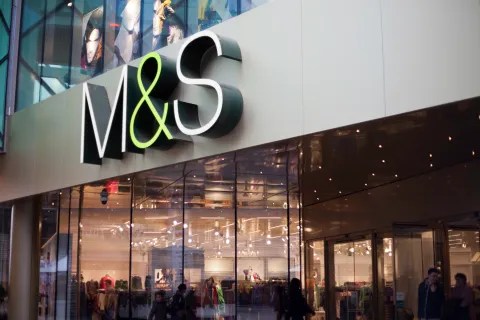M&S is set to close another two stores for good leaving shoppers devastated.
The retailer is pulling the shutters down on its locations in Crawley and Doncaster.
The Doncaster store, located in Baxtergate, has been in the town centre for more than 50 years, and shoppers have branded the closure “disgusting”.
Taking to social media, one person said: “This is terrible its a great shop to go to.”
Another added: “Disgusting! They should reconsider this!”
While another commented: “The city is in terminal decline.”
Read more on Money
It is not all bad news as the retail giant is moving to a nearby retail park unit on Wheatley Hall Road, according to local news outlet Doncaster Free Press.
It’s disgusting they should reconsider this!
Social Media user
However, shoppers are complaining that it is not very accessible for people who do not drive.
One person said: “This means my mum would need to go on two buses just to get there which would be a nightmare for her.”
Residents of Crawley are feeling much the same about the loss of their local M&S.
Most read in Money
The store, located in Queensway, has been around for decades and one council member told local news outlet, The Argus that the decision to close the store was “a real blow for the town centre”.
One local wrote on Facebook that it was “such a shame” and another said it is “the only decent shop in Crawley”.
A third angry shopper said: “This is a travesty!”
While a fourth commented: “We won’t have anywhere in our town soon.”
Earlier this year, the retailer confirmed that it would also be closing its Walworth store in South London.
The popular store has been serving locals for over 100 years and the news has come as a shock to the community.
Commenting on the Walworth closure, Gordon Scott, M&S regional manager, said the proposal to close the store was due to “changing shopping habits”.
The Sun has reached out to M&S for comment on the Doncaster and Crawley store closures.
In 2022, the retailer announced plans to shut 67 “lower productivity” stores as part of a five-year plan to shake up its branch portfolio.
M&S, which runs 405 stores across the country, shut down locations in Manchester, Swindon and Birmingham between August and November last year.
In addition to this, 40 M&S clothing stores closed between November 2016 and July 2023.
If you want to know if your local might be next, we have the full list of M&S stores that are marked for closure in 2024.
However, it is not all bad news for the retailer, or shoppers as in January 2023, it announced it would open 20 more stores over the financial year.
At the same time, it said it’s opening 104 new “bigger and fresher” food stores.
In the last 12 months, it has opened 22 sites including in Liverpool, Leeds, Birmingham and Manchester.
What else is happening on the high street?
Marks and Spencer is not the only retailer switching things up and making some changes to its store portfolio.
A combination of rising rent and cost of living has meant that many large companies have had to re-look at how they run their business.
Other retailers such as Iceland, Boots and Matalan have also been timing back their store portfolio and shutting down branches.
Just this month Boots has announced that it will be closing a total of nine sites, as part of its wider plans to get rid of 300 locations.
These closures will see the retailer’s total shops reduced from 2,200 to 1,900.
This has upset a lot of locals in the affected towns, however, the health and beauty chain has said where stores are closing there is an alternative shop less than three miles away.
Last year Argos started to put in place its plans to reduce the number of standalone stores and focus on opening more locations inside Sainsbury’s supermarkets.
It closed 42 UK shops, including all 34 of its branches in the Republic of Ireland last June.
However, things are looking up for other retailers, and despite the difficult trading conditions some are expanding the number of stores they have.
Primark recently confirmed plans to open new branches and invest and renovate more than a dozen of its existing shops.
Meanwhile, Asda is massively expanding its portfolio of smaller Express stores, with plans to open 110 new stores.
READ MORE SUN STORIES
Popular discounter B&M also said it had plans to open 17 new sites in 2024 with some set to open imminently.
We have the full list of chains opening stores in 2024 – see if one is coming to a high street near you.
Why are retailers closing stores?
RETAILERS have been feeling the squeeze since the pandemic, while shoppers are cutting back on spending due to the soaring cost of living crisis.
High energy costs and a move to shopping online after the pandemic are also taking a toll, and many high street shops have struggled to keep going.
The high street has seen a whole raft of closures over the past year, and more are coming.
The number of jobs lost in British retail dropped last year, but 120,000 people still lost their employment, figures have suggested.
Figures from the Centre for Retail Research revealed that 10,494 shops closed for the last time during 2023, and 119,405 jobs were lost in the sector.
It was fewer shops than had been lost for several years, and a reduction from 151,641 jobs lost in 2022.
The centre’s director, Professor Joshua Bamfield, said the improvement is “less bad” than good.
Although there were some big-name losses from the high street, including Wilko, many large companies had already gone bust before 2022, the centre said, such as Topshop owner Arcadia, Jessops and Debenhams.
“The cost-of-living crisis, inflation and increases in interest rates have led many consumers to tighten their belts, reducing retail spend,” Prof Bamfield said.
“Retailers themselves have suffered increasing energy and occupancy costs, staff shortages and falling demand that have made rebuilding profits after extensive store closures during the pandemic exceptionally difficult.”
Alongside Wilko, which employed around 12,000 people when it collapsed, 2023’s biggest failures included UK Flooring Direct, Planet Organic and Tile Giant.
The Centre for Retail Research said most stores were closed because companies were trying to reorganise and cut costs rather than the business failing.
However, experts have warned there will likely be more failures this year as consumers keep their belts tight and borrowing costs soar for businesses.
Last year, around 14% of insolvencies were in retail businesses, according to official figures.









